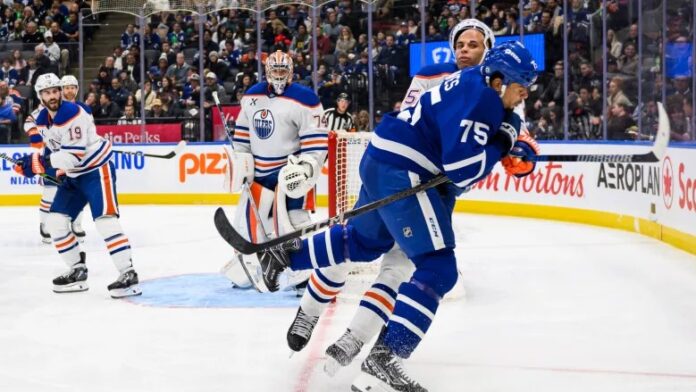
The National Hockey League (NHL) has faced a complicated issue in recent years. The divide created by suspensions, particularly the number of games a player should get for committing a forbidden act outside the league’s rulebook, often sparks outrage and debate among fans.
Every time a dirty hit takes place, or a player commits a suspendable act, hockey fans become divided, taking to social media to voice their opinions on the instance. Much of the argument centers around how many games a player should get for their actions – everyone has their own opinion.
The recent suspensions of Tanner Jeannot and Ryan Reaves are a case study. Both players received suspensions for a similar play. They both left their feet to deliberately deliver a headshot to an opposing player.
On Nov. 7, Jeannot targeted Brock Boeser, a forward for the Vancouver Canucks, with his elbow, getting a three-game suspension for the play. Later on Nov. 16, Reaves targeted Darnell Nurse, a defenseman for the Edmonton Oilers, with a comparable elbow shot. Reaves earned himself a five-game sentence.
After the hits took place, many fans were divided around the discrepancy in the amount of games each player received. Some thought that the offending players should have received more, while others thought they should have received less.
“There is some onus on the player with the puck to be aware of where everyone is on the ice. With that said, even if you put yourself in a bad spot there is a lot of body on a 6’4” hockey player to hit and not one piece was touched other than my head,” said Nurse to theScore.ca on the hit he received from Reaves.
“You can argue about the intent, but there’s certain guys in this league that go out there every shift and try to inflict pain and I think it’s pretty obvious what was going on there.”
Despite the opposing opinions on the issue, there are a few rules and regulations that the NHL’s Department of Player Safety must follow and consider when handing down supplemental discipline. Many of those rules follow the collective bargaining agreement, or CBA, which is signed between the NHL and the NHL Players’ Association.
One of the main rules around suspension is laid out in section eight of the agreement.
According to the section, there are five points the league considers when handing down suspensions.
The type of conduct involved, injury to the opposing player, the offender’s status and whether the player has a history of suspension are all considered.
Players who repeatedly violate league rules will be more severely punished for each new violation and the situation of the game when the incident occurred. For instance, if the hit occurred later in the game or the game was lopsided, then the NHL would take the situation into account.
Along with section eight, the possibility of whether the player is a repeat offender also comes into play when handing down a suspension.
To be a repeat offender, the NHL says a player commits a suspendable act “for 18 months following his most recent incident that resulted in a suspension.” In addition, you must have a history of suspensions throughout your NHL career. Those with a checkered past are punished harder than first-time offenders.
In the Jeannot case, his recent suspension was the first of his career – dropping the repeat offender designation. Boeser was injured in the play and Jeannot received a match penalty.
In the contrasting case, Reaves has been suspended three times in his career and the league determined that Reaves had adequate time to avoid targeting Nurse’s head during the play.
Although these rules exist, some were still critical of the NHL’s handling of the Jeannot and Reaves suspension. One of those people was Sportsnet commentator Luke Gazdic.
“I don’t like it at all,” Gazdic said on air.
“Throw the book at him, he’s done it a couple times before. I think if you [want to] stop these hits, like, get them out of the game, why not throw the book at him?”
The NHL has been pressured to get these calls right. On one hand, the league wants to punish offenders for foul play but, they risk upsetting fans and ruffling feathers with their judgments.
Despite this conundrum, the NHL does its best to uphold a high degree of care and safety for its players – a standard that will likely be in place for years to come.
